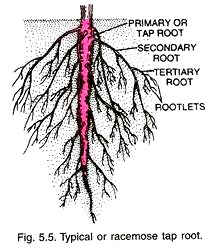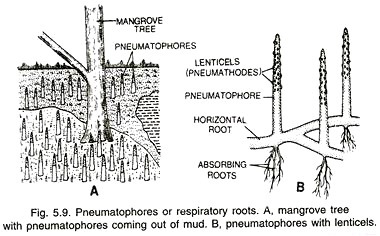In this article we will discuss about:- 1. Definition of Tap Root System 2. Types of Tap Root System 3. Modification 4. Modification of Tap Root Branches.
Definition of Tap Root System:
It is a mass of roots which develops from the radicle of the embryo. It consists of a tap root, secondary roots, tertiary roots and rootlets (Fig. 5.5).
The radicle itself grows up directly into the main or primary root. The persistent primary root is known as tap root. It is usually the most prominent, thickest and largest of all. Tap root becomes gradually narrow towards the tip. Secondary and tertiary roots are respectively the branches of first and second order.
They are formed in acropetal succession (youngest towards growing point and oldest towards the base of the parent root). In orientation the tap root is vertical, secondary roots are horizontal or oblique while the tertiary roots run in different directions. Rootlets are the ultimate root branches. They bear root hairs for absorption.
Types of Tap Root System:
Tap root system is of two types— deep feeder and surface feeder. Deep feeder tap root system has an elongated tap root which penetrates the deeper layers of the soil. It is mostly met in trees. Deep feeder tap root system is also called racemose tap root system.
In surface feeders the tap root does not elongate very much. The secondary roots spread to a greater extent, mostly horizontal near the soil surface. Such a system is also named as cymose tap root system. The cymose or surface feeder tap root system of some annual plants consists of thin fibrous roots. It may be called fibrous tap root system.
Modification of Tap Root System:
The tap root becomes swollen and fleshy with the stored food. The secondary roots remain thin. Hypocotyl (embryonic region between cotyledons and radicle) may also join the tap root in storing food. Stem is reduced and discoid in the beginning and bears radical leaves.
Depending upon the shape, the fleshy tap roots are of the following types:
(i) Conical:
Here the fleshy tap root resembles a cone, that is, the thickest towards base and gradually tapering towards the apex (Fig. 5.6 A). Many thread-like secondary roots are found throughout the length of conical fleshy root, e.g., Carrot (Daucus carota).
(ii) Fusiform:
The fusiform fleshy root is like a spindle, that is, thickest roughly in the middle and narrow towards both its base and apex, e.g., Radish (Raphanus sativus, vern. Mooli). The fusiform root of Indian Radish consists of swollen hypocotyl near the base only and swollen tap root in the remaining region (Fig. 5.6 B).
The latter possesses thin and thread-like secondary roots. In European Radish (Fig. 5.6 C) the tap root forms only the terminal tapering fleshy part of the root. The middle and the basal fleshy parts are formed by the hypocotyl.
(iii) Napiform:
The fleshy root is very thick at the base and is almost spherical. It suddenly thins out towards the apex (top-like), e.g., Turnip (Brassica rapa, vern. Shalgam) and Beet (Beta vulgaris, vern. Chakander). In Turnip most of the swollen part is hypocotyl. The tap root occurs only towards the narrow pointed apical region which also bears threadlike secondary roots (Fig. 5.6. D). In Beet both the tap root and hypocotyl are swollen.
(iv) Tuberous Roots:
They are those thickened tap roots which do not assume any definite form, e.g., Mirabilis jalapa (Four O’ Clock) (Fig. 5.7), Trichosanthes (vem. Parwal), Echinocystis lobata. In Echinocystis lobata the tuberous root is lobed and weighs as much as 22 kg. 
Modification of Tap Root Branches:
i. Nodulated (Tuberculate) Roots:
They occur in papilionaceous (leguminous) plants like Pea (Pisum sativum), Gram (Cicer arietinum), Groundnut (= Peanut, Arachis hypogea), Methi (Medicago falcata), Soy Bean (Glycine max), Alfalfa, etc.
The secondary, tertiary roots and sometimes the primary root develop numerous small or large irregular swellings called root nodules or tubercles (Fig. 5.8). The root nodules enclose millions of minute nitrogen fixing bacteria of the genus Rhizobium (e.g., R. leguminosarum).
These bacteria pick up the free nitrogen present in the soil atmosphere and convert it into organic compounds of nitrogen. The property of converting free nitrogen into nitrogenous compounds is called nitrogen fixation.
Some of the nitrogenous compounds are taken up by the legume in return for food and shelter. Therefore, both the bacteria and the leguminous plant are benefitted by their association. Such a mutually beneficial relationship is called reciprocal symbiosis or mutualism.
ii. Pneumatophores (= Aerophores = Respiratory Roots, Fig. 5.9):
They are breathing or respiratory roots which are found in plants growing in mangroves or saline swamps near the sea shore, e.g., Avicennia, Sonneratia, Heritiera (vern. Sundri). The plants possess spreading horizontal cable roots. The horizontal roots develop upright aerial roots or pneumatophores at short intervals. Short downwardly growing absorbing roots are formed from the bases of pneumatophores.
Pneumatophores or respiratory roots come out of water and pick up oxygen for perspiration of roots. Excess CO2 is also given out. For this they bear small pores called lenticels (= pneumathodes) near their tips. The remaining surface of pneumatophores is covered by cork.



